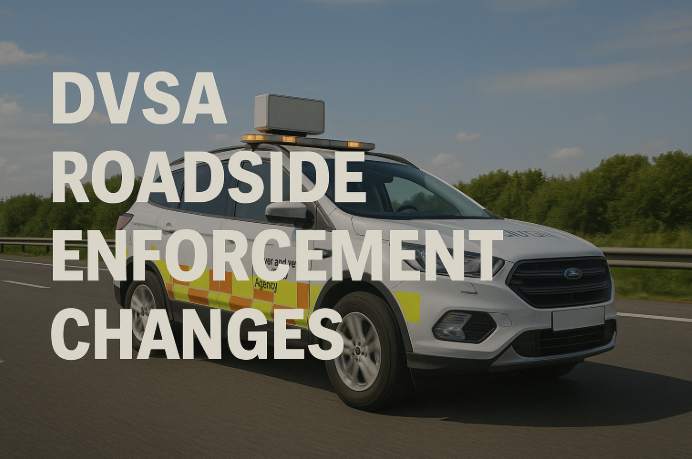Learner drivers and general motorists in the UK face updated and more rigorous DVSA roadside enforcement changes in 2025. This article explores enforcement sanction updates, technological advances, regional differences, and future reforms, integrating deep driver-focused insights. Throughout this piece, you’ll find key NLP and LSI keywords such as “roadside inspections”, “mobile payment”, “ANPR enforcement”, “defect detection”, and “Driver and Vehicle Standards Agency” naturally woven into the content to boost SEO value.
What Are the Latest DVSA Roadside Enforcement Sanction Updates?
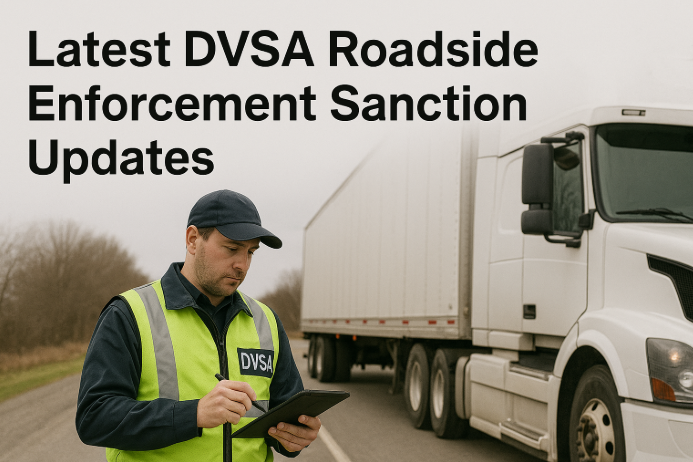
The Driver and Vehicle Standards Agency (DVSA) introduced significant updates to its Enforcement Sanctions Policy on 6 June 2025, aimed at improving consistency, safety, and regulatory compliance during roadside checks for commercial and passenger service vehicles.
These updates focus on expanding offence codes, refining penalty guidelines, and promoting the use of mobile payment systems for roadside fines.
What specific new sanction codes were added in June 2025?
-
As part of the June 2025 revision, DVSA added several new Public Service Vehicle (PSV) offence codes to better categorize violations and ensure clarity in enforcement procedures. Key additions include:
-
11-11 – Operating a vehicle without the correct PSV operator licence
-
11-11A – Renting or rewarding a PSV vehicle without the required authority
-
11-13 – Operating a vehicle in breach of a prohibition notice
Why These Changes Matter:
-
These new codes enable enforcement officers to clearly identify specific breaches.
-
Depending on the kind and seriousness of the crime, they expedite the imposition of warnings, set fines, or vehicle restrictions.
-
The update aims to promote uniform decision-making across the DVSA’s enforcement teams, ensuring fairer and more transparent roadside inspections.
-
How much have mobile payment fines changed?
The DVSA has modernised its fine collection system to include digital and contactless payment options. Now, drivers and operators can pay fixed penalties directly at the roadside using:
-
Apple Pay
-
Google Pay
-
Major debit and credit cards
This shift reduces administrative delays and encourages immediate compliance, preventing unnecessary immobilization or court referrals.
Revised Fixed Penalty Ranges (as of June 2025):
-
Minor infringements: £50
-
Moderate offences: £100–£200
-
Serious breaches (e.g. licensing or safety violations): up to £300
DVSA officers may still issue immediate prohibitions or initiate court proceedings for severe or repeated violations. In certain cases, vehicle immobilization is applied until fines are paid or defects rectified.
How Are Roadside Inspection Procedures Evolving in 2025?
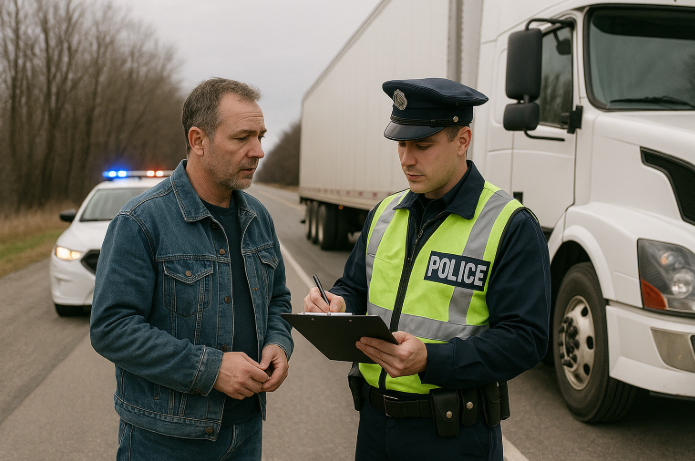
Roadside enforcement in the UK is undergoing a major transformation in 2025. The Driver and Vehicle Standards Agency (DVSA) is embracing automation, data integration, and smart enforcement to enhance road safety while reducing manual errors and inefficiencies.
What advanced monitoring tech is being introduced?
The DVSA is trialing cutting-edge technology to revolutionize how inspections are carried out. Notable advancements include:
-
Automated Weigh Pads: These allow for rapid vehicle weight checks without prolonged manual weighing procedures.
-
Under-Vehicle Robot Scanners: These mobile scanners can inspect the underside of vehicles for structural defects, leaks, or tampering, enhancing precision while reducing the time spent on inspections.
These technologies are part of DVSA’s broader mission to streamline roadside checks, reduce traffic disruption, and make enforcement decisions more evidence-based and less subjective.
How will ANPR enrich enforcement at roadside and behind the scenes?
-
Live access to real-time vehicle data via police and commercial ANPR cameras
-
“Enforcement from the record” strategies, where vehicles are flagged for potential breaches before they are stopped
-
A vast network of 12,000–13,000 ANPR cameras reading approximately 50 million licence plates daily
-
Retention of ANPR data overlays for up to 24 months, aiding in long-term investigations
Why Are These DVSA Roadside Enforcement Changes Happening?
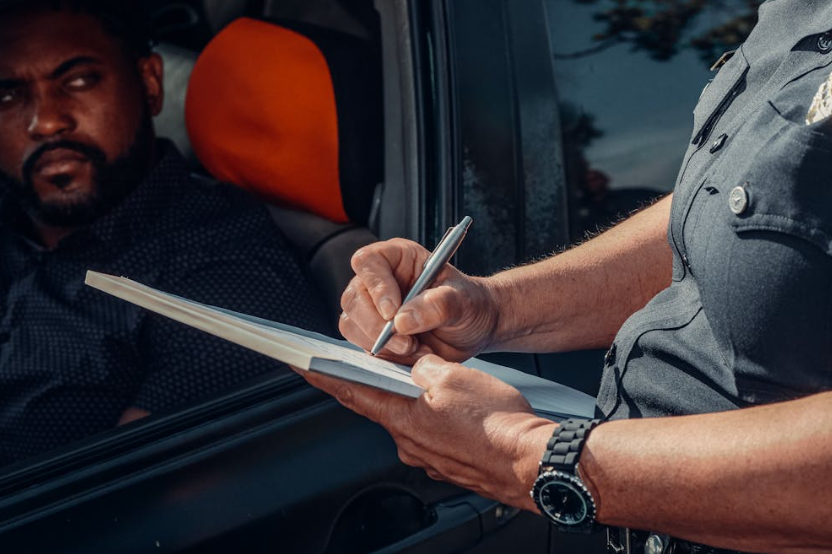
What goals drive the new enforcement strategy?
The DVSA’s Strategic Plan to 2025 focuses on building a safer and more sustainable transport system by using smart, digital-led enforcement. Key objectives include:
-
Enhancing test and licensing systems
-
Modernizing inspection methods
-
Reducing non-compliance through proactive risk detection
Their 2024–25 Business Plan reinforces this direction by investing in technology that supports digital licensing, safer driver training, and high-risk operator targeting.
How are these changes aligned with wider road safety needs?
Since 2010, the UK has seen a 22% decline in active roads policing officers, raising concerns about diminishing enforcement visibility. To address this, the DVSA is stepping up with:
-
A greater presence of roadside enforcement units.
-
Increased use of technology to enforce laws remotely.
-
Emphasis on reducing the “Fatal Four”: speeding, mobile phone use, lack of seatbelt use, and drink/drug driving.
By integrating digital intelligence tools, the DVSA is aiming to plug the enforcement gap left by reduced police manpower and keep the roads safer for all.
How Do These Changes Affect Learner Drivers and General Road Users?
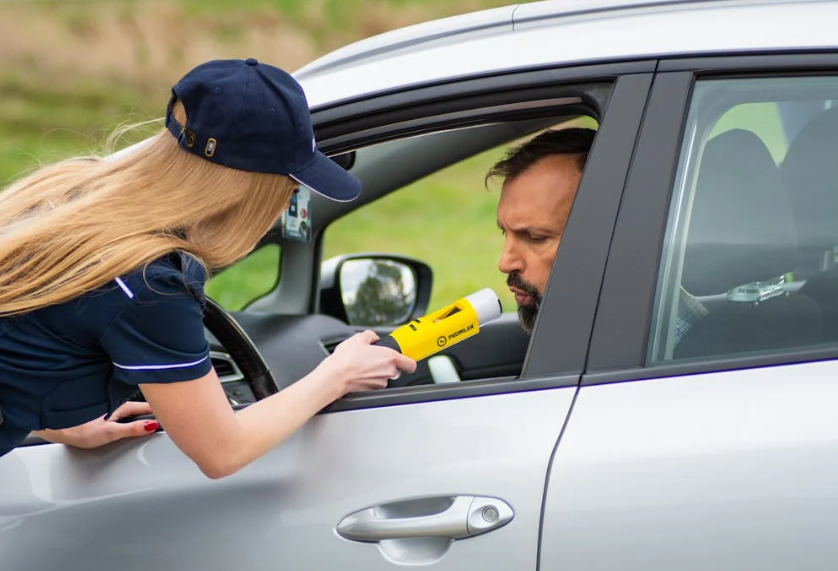
What new challenges do learner drivers face with updated sanctions?
Learner drivers must now navigate a more complex regulatory environment. Key concerns include:
-
Being penalized for violations tied to PSV-related offence codes
-
Facing higher penalties (up to £300) for non-compliance, incorrect documentation, or expired learner permits
-
Risking test disqualification and insurance rejection if records aren’t fully compliant
Provisional licence holders are advised to stay informed about any changes to eligibility, offence codes, and penalties.
How will general motorists experience roadside checks differently?
With data-driven targeting, the intensity and likelihood of inspections will vary depending on your risk profile. For example:
-
Drivers flagged by ANPR systems are more likely to face full inspections
-
Routine checks may become more streamlined using automated tools
-
Fines can now be paid instantly via mobile payment systems, avoiding vehicle seizure
However, failure to comply or refusal to pay roadside penalties can escalate to:
-
-
Vehicle immobilization
-
Increased fines or penalties
-
Legal proceedings within one to two weeks
-
What Are the Consequences of Failing to Pay a DVSA Fine?

-
Vehicle immobilization or removal
Drivers who ignore payment codes or refuse to pay risk having their vehicle immobilized or towed. Travel delays and additional costs may result from this. -
Escalating penalties
Unpaid fixed penalties automatically increase by 50% if not settled within 28 days—mirroring police-issued notice processes. -
Legal enforcement and court action
DVSA can escalate unpaid, serious, or repeated offences to court for prosecution, resulting in:-
Heavier fines,
-
Criminal record entry,
-
Additional court costs and legal fees.
-
-
Licence endorsement or disqualification
Endorsable offences—like drivers’ hours or serious licence breaches—can add penalty points, potentially leading to disqualification, delayed licence acquisition for learners, or increased insurance premiums. -
International traveller impact
Foreign-registered vehicles lacking UK address must pay a deposit upfront. Non-payment can result in vehicle seizure until resolved. -
Civil enforcement via courts
Unpaid penalties become court-registered debts, leading to bailiff action, credit rating damage, or enforcement warrants . -
Credibility and compliance perception
Non-payment raises red flags with DVSA and operator records, increasing risk of future roadside checks or prohibition notices. It also undermines Operator Compliance Risk Score (OCRS) for fleet operators.
Summary of Mobile Payment Steps & Consequences
| Action | Driver Response | Consequences of Inaction |
|---|---|---|
| Offence found → Mobile payment available | Pay via Apple/Google Pay or cards at roadside | Delay; examiner may immobilize vehicle |
| Payment deferred → payment code sent | Pay within 28 days online/phone/post | +50% fine; possible court action |
| Serious or repeated offence | May include endorsement or court reference | Higher fine, points, disqualification, court costs |
| Foreign vehicle/no UK address | Upfront deposit required | Vehicle can be seized until payment received |
What Do Recent DVSA Performance Statistics Show?

What are the latest figures on roadside checks?
Here’s updated data from Q3 2024–25 (Oct–Dec) on GB’s roadside mechanical and traffic checks
| Vehicle Type | Inspected | Cat 1 Defects (%) | Prohibition Rate (%) | Fixed Penalty Income |
|---|---|---|---|---|
| Cars | 170 | 31 | 75.3 | £4,100 |
| HGV | 2,619 | 41 | 40.96 | £87,000 |
| LGV | 1,639 | 30 | 26.52 | £105,350 |
| PSV | 688 | ~20 | 19.9 | £5,600 |
Total fixed penalties approached £200,000, and Cat 1 defect rates among HGVs, LGVs, and cars remain high.
How Does the New DVSA Fine Payment System Work?
| Step | Description | Details |
|---|---|---|
| 1️⃣Offence Identified | DVSA examiner stops a vehicle for an offence | Common issues: lighting, overloading, licence infractions |
| 2️⃣Penalty Notice Issued | A Fixed Penalty Notice (FPN) is created | Includes amount, offence code, and payment instructions |
| 3️⃣Payment Code Provided | Driver receives a unique payment reference | Sent via SMS or email instantly |
| 4️⃣Payment Options Offered | Multiple payment methods available | – Apple Pay / Google Pay – Contactless card – Online payment – Bank transfer or cheque (with delay) – Cash (in select scenarios) |
| 5️⃣Immediate Payment Encouraged | Mobile payment preferred at roadside | Faster processing, avoids immobilization |
| 6️⃣Vehicle Release or Penalty Deferred | If paid: vehicle released immediately If deferred: grace period granted |
Vehicle may be held or released depending on payment and offence |
| 7️⃣Non-Payment Follow-Up | Unpaid within 28 days → fine increases | +50% surcharge; possible legal action or vehicle immobilization |
Are defect levels trending upward or downward?
Although the number of fatal crashes in the UK has remained relatively stable over the past decade, the Driver and Vehicle Standards Agency (DVSA) continues to expand its roadside inspections with the aim of reducing roadworthiness-related failures—particularly Category 1 defects, which pose immediate safety risks. These intensified checks are expected to help lower the rate of unsafe vehicles on the road and contribute to long-term safety improvements.
Which Regional Differences Shape Enforcement in the UK?

How do practices differ between England/Scotland/Wales vs Northern Ireland?
-
The Driver and Vehicle Agency (DVA) is in charge of Northern Ireland, whereas the DVSA is in charge of Great Britain.
-
While mobile payments and digital enforcement are uniform across GB, their rollout in NI trails by approximately 6–12 months.
-
ANPR deployments vary across police force areas, with Scotland’s and Wales’ camera density slightly lower, leading to localized enforcement variations.
| Area | DVSA Presence | Mobile Pay Launch | ANPR Usage |
|---|---|---|---|
| England, Scotland, Wales | YES | May 2025 | Nationwide |
| Northern Ireland | NO (DVA) | Rolling out later | Less coverage |
Do police force priorities shape enforcement success?
Yes. The reduction of roads policing officers by 22% since 2010 has placed more pressure on automated and DVSA-led enforcement. Still, 44% of police forces explicitly prioritize roads policing in their strategic plans.
Forces that invest in traffic enforcement consistently report:
-
-
Lower rates of fatal and serious collisions
-
Reduced offences related to mobile phone use
-
Better detection of uninsured or unroadworthy vehicles
-
How Does DVSA’s Operator Compliance Risk Score (OCRS) Affect Roadside Checks?

What is OCRS and how is it used?
The Operator Compliance Risk Score (OCRS) is a tool used to assess commercial vehicle operators based on:
-
Historical data from roadside inspections
-
Regulatory compliance history
-
Vehicle maintenance records
Operators with high-risk scores are more likely to be targeted for roadside stops, while those enrolled in the DVSA’s Earned Recognition scheme (indicating exceptional compliance) are generally exempt from routine checks.
Is OCRS useful for general motorists or learner drivers?
OCRS applies specifically to commercial operators, but the underlying principle still matters:
-
Maintaining clean vehicle records
-
Passing MOTs and servicing on time
-
Keeping insurance and tax up to date
Doing so minimizes the likelihood of being stopped or fined—especially as ANPR becomes more integrated.
What Technology Redefines 2025 Roadside Enforcement?

How does ANPR enforcement really work?
DVSA and UK police forces now harness a network of 12,000–13,000 ANPR cameras, capturing approximately 50 million licence plate reads per day. This data is used to:
-
Identify vehicles without valid MOTs, road tax, or insurance
-
Flag commercial vehicles with poor compliance records
-
Share data across agencies for criminal and regulatory enforcement
The DVSA can now pre-identify non-compliant vehicles before stopping them, significantly reducing inspection times and improving roadside efficiency.
What is under‑vehicle scanning and how is it used?
The DVSA deploys robotic under-vehicle scanners that utilize:
-
High-resolution imagery
-
Thermal imaging
-
Real-time diagnostics
These tools can detect:
-
Structural weaknesses (e.g., cracks, corrosion)
-
Brake system issues
-
Exhaust and suspension issues that are not obvious during a routine visual examination
This boosts defect detection rates and enhances road safety assessments for both private and commercial vehicles.
What Is DVSA Planning for Future Enforcement (2026–30)?
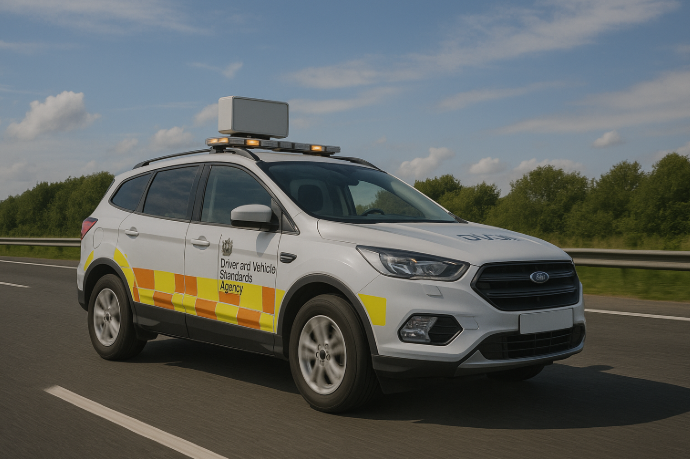
Will full digitization of MOTs be enforced?
DVSA’s Vision to 2030 includes a target to fully digitize MOT records and integrate them into ANPR systems, enabling remote enforcement by 2027.
What about ADAS and emission checks at roadside?
From 2026 onwards, DVSA plans to:
-
Expand roadside checks for Advanced Driver Assistance Systems (ADAS), including emergency braking and lane-keeping technologies.
-
Enhance emissions compliance through real-world emissions tests at the roadside.
These initiatives support the UK’s commitment to environmental standards and modern vehicle safety technology regulation.
How Should Drivers Adapt to 2025 Changes?
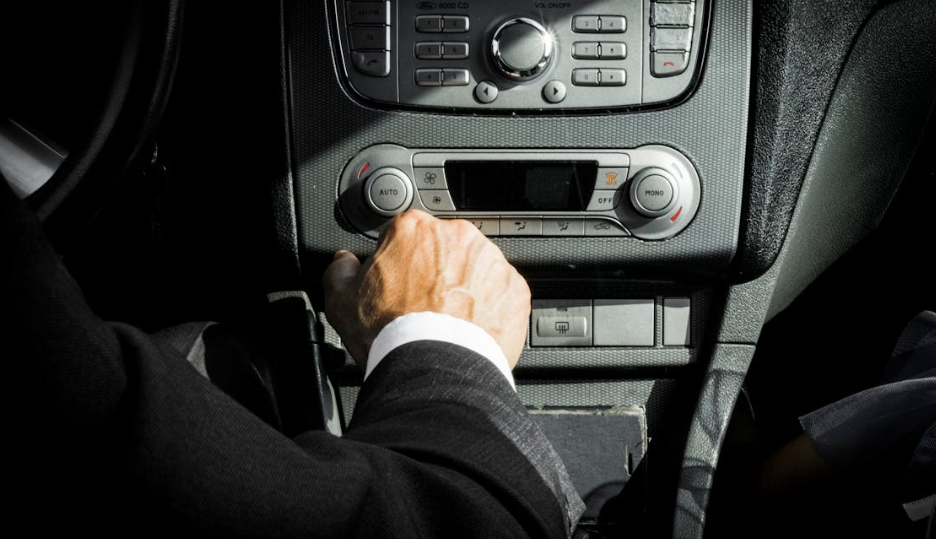
What should learner drivers do to stay compliant?
-
✅ Always carry provisional licence and learning documentation.
-
✅ Ensure instructor vans display correct licence and safety markings.
-
✅ Use Apple Pay/Google Pay apps and keep devices charged during drives.
-
✅ Regularly review offence code updates associated with new PSV guidance.
How can general motorists stay ahead?
-
Schedule periodic vehicle maintenance focusing on brakes, tyres, wiring, lights.
-
Keep V5C, MOT, insurance, licence documents accessible.
-
Pre-install mobile wallets and store payment options for roadside checks.
-
Stay informed of regional DVSA or police communications and check for ANPR alerts.
Conclusion
The DVSA roadside enforcement changes in 2025 signify a major shift—moving from manual, cash-based operations to swift, tech-enabled compliance checks. For learner drivers and general motorists, preparation is essential:
-
Understand new offence codes and fixed penalty ranges.
-
Embrace mobile payments to avoid penalties or impoundment.
-
Ensure vehicle safety and documentation are current.
-
Prepare for more sophisticated inspection technologies.
FAQs
What happens if I can’t pay immediately at the roadside?
DVSA issues a payment reference via text or email. You have a certain amount of time to make your phone or online payment. Court procedures or immobilization may result from failure.
Can I appeal after paying by mobile?
Yes—payment does not waive your right to appeal. You must follow DVSA’s official appeal process after settling the fine.
Do enforcement changes apply across the UK?
Yes in Great Britain (England, Wales, Scotland). NI has separate timings and systems via the DVA—mobile payments and ANPR digitization are trailing by several months.

I’m Joe Chris, co-author at ukbusinessmag.co.uk and a long-time enthusiast of all things business and finance. My background is in digital marketing and e-commerce, and I love diving into trends that impact the UK business landscape. Through my writing, I aim to make useful, real-world advice accessible to business owners.

